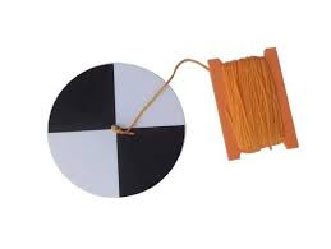Secchi disc is a simple type of round plate painted with successive black and white colors. Angelo Secchi created the Secchi disc in 1985. A thread is hung in the center of the plate or disc. The diameter of the plate is around 30 cm or 12 inches which is white-black in color.
The disc is hung by 3 colors of plastic thread. The color of the first part is red (20 cm), the color of the second part is green (10 cm) and the color of the last part white which is 100-120 cm in length.
A stick or rod is placed at the end of the thread or rope. The plate of secchi disc with black and white color at which depth is not visible is called secchi disc reading. This measure is known as secchi disc and is related to turbidity. It is used to measure the clarity of a reservoir or the ponds.

Secchi Disc
The actual secchi disc was a flat white disc and was used in the Mediterranean. Currently it is a flat white 30 cm. (12 inches) diameter standard design used in marine research. In 1899, George C. Whipple transformed the original white secchi disc into a disc about 6 inches in diameter and divided it into four parts, dyeing them in black and white, alternately with a spotted rod. This modified black and white secchi disc is a standard disc that is currently used in the study of limnology.
Secchi disc depth refers to the depth at which light can be reflected and returned. Secchi disc readings do not carry the identity of the actual measure of transparency. The unbearable intense light of the sun fell on the water or one person saw the disk at a certain depth, but another person with good eyesight saw it at a greater depth.
You might also read: Eutrophication: Causes, Impacts and Control Strategies
Secchi disc may vary in viewing ability. However, it is a less expensive and easier way to measure transparency. The measurement method should be of as high a standard as possible due to differences in the readings of secchi disc users. Secchi disc measurements should be taken from the shady side of the boat or dock from 9 a.m. to 3 p.m. Good results are available between 10 a.m. and 2 p.m. Secchi disc depth should be measured in the same manner every time by a person. One method of measurement is that when the disk disappears at a point when submerged in water, it has to be lifted and submerged again in a short time and placed at a dry depth. Another method is to keep a record of the depth at which the Sekki disk disappears. It is then slowly lifted, keeping a record of the depth at which the disc became visible by dipping a few feet. Secchi depth is taken from the average value of these two.
In 2013, a team of marine scientists set up the Global Citizen Science secchi disc Program to study Plankton( phytoplankton) at sea. They use a flat white marine secchi disc with a diameter of 30 cm.
Water Transparency: There is a high correlation between the visibility of Secchi disc and the density of phytoplankton (water color). High Secchi disc reading is related to the low productivity of the pond and Less secchi disc reading is related to the high productivity of the pond. Generally, high productivity ponds have more organisms which increase the use of oxygen and cause oxygen deficiency in the pond water.
Method For Using Secci Disc:
If the white part of the dish is not seen after dipping the red thread in water, it should be understood that there is extra food in the pond. However, even if the water is turbid, this condition can occur. In this case, it is not suitable for realising of any baby fish and it is not suitable to use extra fertilizers and supplements. If you see the white part of the dish even after dipping the white thread, you will understand that there is less food. In this case, more fertilizer should be given.

Method For Using Secchi Disc
If there are fry in the pond, food application should be maintained. If the white part of the dish is not seen after dipping the green thread in water, then it should be understood that the food is in moderation. In this condition, fry or baby fish can be left without fertilizer.
